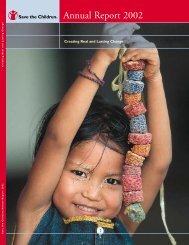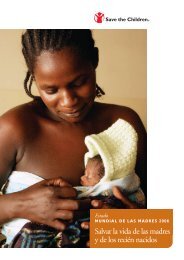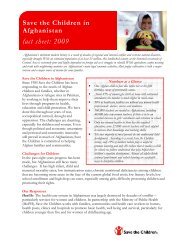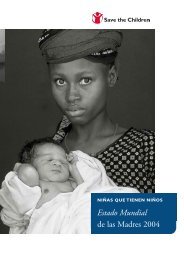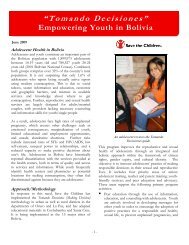Adolescent Sexual and Reproductive Health Toolkit for - UNFPA
Adolescent Sexual and Reproductive Health Toolkit for - UNFPA
Adolescent Sexual and Reproductive Health Toolkit for - UNFPA
Create successful ePaper yourself
Turn your PDF publications into a flip-book with our unique Google optimized e-Paper software.
• Pregnant adolescent girls, particularly those under 16,<br />
are at increased risk of obstructed labor, a lifethreatening<br />
obstetric emergency that can develop<br />
when the immature pelvis is too small to allow the<br />
passage of a baby through the birth canal. Delay in<br />
treatment can lead to obstetric fistula or uterine<br />
rupture, hemorrhage <strong>and</strong> death of the mother <strong>and</strong><br />
child. Emergency obstetric care services are often<br />
unavailable in crisis settings, increasing the risk of<br />
morbidity <strong>and</strong> mortality among adolescent mothers<br />
<strong>and</strong> their babies.<br />
• Marginalized <strong>Adolescent</strong>s, including those who are<br />
HIV+, those with disabilities, non-heterosexual<br />
adolescents, indigenous groups <strong>and</strong> migrants may<br />
face difficulties accessing services because of<br />
stigma, prejudice, culture, language <strong>and</strong> physical or<br />
mental limitations. They are at risk of poverty. In<br />
addition, they are at risk of SEA because of their<br />
lack of power <strong>and</strong> participation.<br />
Sub-groups that become at-risk<br />
during a crisis situation:<br />
• <strong>Adolescent</strong>s separated from their families (parents or<br />
spouses) <strong>and</strong> adolescent heads of household lack the<br />
livelihood security <strong>and</strong> protection af<strong>for</strong>ded by the<br />
family structure, which puts them at risk <strong>for</strong> poverty<br />
<strong>and</strong> SEA. Separated adolescents <strong>and</strong> adolescent<br />
heads of household may be compelled to drop out<br />
of school, marry or sell sex in order to meet their<br />
needs <strong>for</strong> food, shelter or protection.<br />
• Survivors of sexual violence <strong>and</strong> other <strong>for</strong>ms of<br />
gender-based violence (GBV) are at risk of unwanted<br />
pregnancy, unsafe abortion, STIs including HIV, as<br />
well as mental health, psychosocial problems <strong>and</strong><br />
social stigmatization.<br />
• <strong>Adolescent</strong> girls selling sex are at risk of unwanted<br />
pregnancy, unsafe abortion, STIs <strong>and</strong> HIV. They are<br />
at risk of abusing drugs <strong>and</strong> alcohol <strong>and</strong> of SEA. For<br />
adolescents below age 18 , this is considered to be<br />
sexual exploitation of children.<br />
• Children Associated with Armed Forces <strong>and</strong> Armed<br />
Groups (CAAFAG), both boys <strong>and</strong> girls, are often<br />
sexually active at a much earlier age <strong>and</strong> face<br />
increased risk of exposure to HIV. Members of<br />
armed <strong>for</strong>ces <strong>and</strong> groups in general, including<br />
adolescents, are at high risk of HIV infection given<br />
their age range, mobility, <strong>and</strong> risk-taking attitudes.<br />
Female combatants, girls associated with fighting<br />
<strong>for</strong>ces, abductees <strong>and</strong> dependants also are frequently<br />
at high risk, given the widespread sexual<br />
violence <strong>and</strong> abuse. They are at risk of mental<br />
health <strong>and</strong> psychosocial problems as they may have<br />
committed or witnessed acts of extreme physical or<br />
sexual violence or may themselves be survivors of<br />
sexual violence. Girls may have been <strong>for</strong>ced to have<br />
sex with comm<strong>and</strong>ers or with other soldiers. They<br />
are at risk of unwanted pregnancy, unsafe abortion,<br />
STIs <strong>and</strong> HIV infection.<br />
Regardless of the source of their vulnerability, all<br />
at-risk sub-groups of adolescents require particular<br />
attention <strong>and</strong> targeted interventions to ensure that<br />
their SRH needs are met during times of crisis.<br />
What special considerations should be<br />
taken when implementing ASRH<br />
programs in emergency settings?<br />
Most of the existing models <strong>for</strong> ASRH interventions<br />
are relevant to the development context; there are<br />
few field-tested models <strong>for</strong> ASRH interventions in<br />
emergency situations. This does not mean that<br />
development models are not valid in emergencies;<br />
in many cases they are, but they must be adapted<br />
to the emergency context. In an acute emergency,<br />
<strong>for</strong> example, life-saving interventions are the priority.<br />
Even in an emergency, every attempt should be<br />
made to involve the beneficiary population in program<br />
planning, implementation <strong>and</strong> monitoring, but<br />
the degree of participation that is attainable may be<br />
less than in a stable or protracted situation. Once the<br />
acute emergency is stabilized, field-tested development-like<br />
interventions, with broader participation<br />
of stakeholders, should be introduced.<br />
Special considerations <strong>for</strong> ASRH programs are<br />
summarized below. It should be noted that each of<br />
these considerations is valid in both the emergency<br />
<strong>and</strong> non-emergency setting, but they may be overlooked<br />
in the emergency context. Further details are<br />
provided in the Fact Sheets <strong>and</strong> individual tools.<br />
In this document, the phrases "humanitarian<br />
settings", "crisis settings" <strong>and</strong> "emergency<br />
settings" are used interchangeably.<br />
8<br />
<strong>Adolescent</strong> <strong>Sexual</strong> <strong>and</strong> <strong>Reproductive</strong> <strong>Health</strong> <strong>Toolkit</strong> <strong>for</strong> Humanitarian Settings




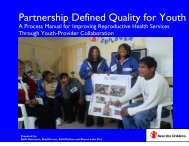

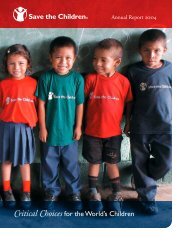
![View full document [PDF 3.39 MB] - PreventionWeb](https://img.yumpu.com/27308954/1/190x245/view-full-document-pdf-339-mb-preventionweb.jpg?quality=85)
